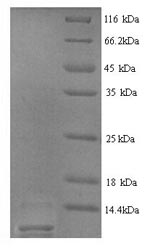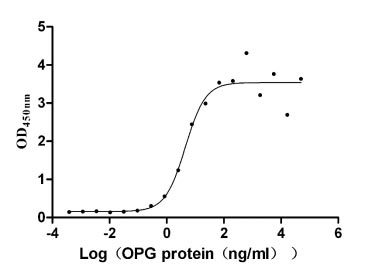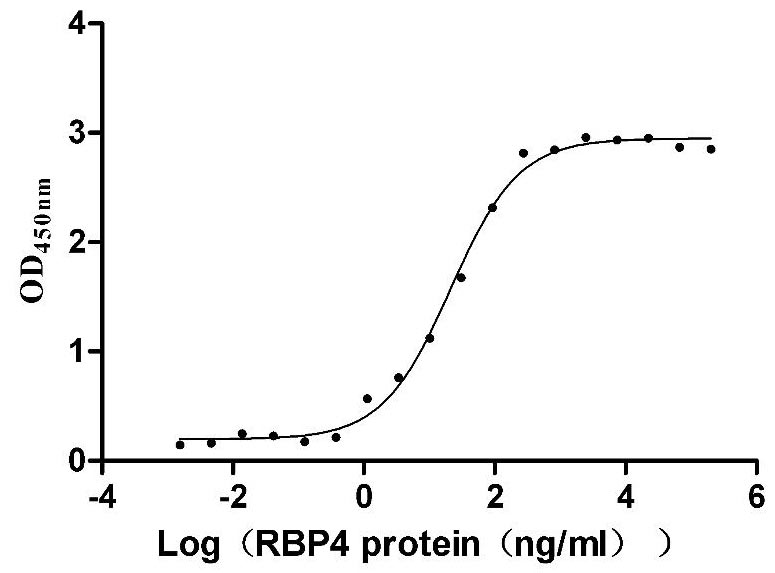Recombinant Rat Type-2 angiotensin II receptor (Agtr2), partial
-
货号:CSB-YP001466RA
-
规格:¥1836
-
图片:
-
其他:
产品详情
-
纯度:Greater than 90% as determined by SDS-PAGE.
-
基因名:
-
Uniprot No.:
-
别名:Agtr2; Type-2 angiotensin II receptor; Angiotensin II type-2 receptor; AT2
-
种属:Rattus norvegicus (Rat)
-
蛋白长度:Extracellular Domain
-
来源:Yeast
-
分子量:6.9kDa
-
表达区域:1-45aa
-
氨基酸序列MKDNFSFAATSRNITSSLPFDNLNATGTNESAFNCSHKPADKHLE
Note: The complete sequence including tag sequence, target protein sequence and linker sequence could be provided upon request. -
蛋白标签:N-terminal 6xHis-tagged
-
产品提供形式:Liquid or Lyophilized powder
Note: We will preferentially ship the format that we have in stock, however, if you have any special requirement for the format, please remark your requirement when placing the order, we will prepare according to your demand. -
缓冲液:Tris-based buffer,50% glycerol
-
储存条件:Store at -20°C/-80°C upon receipt, aliquoting is necessary for mutiple use. Avoid repeated freeze-thaw cycles.
-
保质期:The shelf life is related to many factors, storage state, buffer ingredients, storage temperature and the stability of the protein itself.
Generally, the shelf life of liquid form is 6 months at -20°C/-80°C. The shelf life of lyophilized form is 12 months at -20°C/-80°C. -
货期:Basically, we can dispatch the products out in 1-3 working days after receiving your orders. Delivery time may differ from different purchasing way or location, please kindly consult your local distributors for specific delivery time.Note: All of our proteins are default shipped with normal blue ice packs, if you request to ship with dry ice, please communicate with us in advance and extra fees will be charged.
-
注意事项:Repeated freezing and thawing is not recommended. Store working aliquots at 4°C for up to one week.
-
Datasheet & COA:Please contact us to get it.
相关产品
靶点详情
-
功能:Receptor for angiotensin II. Cooperates with MTUS1 to inhibit ERK2 activation and cell proliferation.
-
基因功能参考文献:
- The present study demonstrated that renal transplantation may cause angiotensin II receptor-mediated vascular contractility associated with changes of epigenetic mechanisms. PMID: 29393347
- Following restraint stress, AT2 receptors in the pre-limbic cortex modulate the tachycardiac component of the autonomic response. PMID: 28695320
- Activation of angiotensin II type 2 Receptor enhances muscle microvascular, oxygenation, and Insulin sensitivity. PMID: 29186390
- Study demonstrates that a tonic activation of angiotensin II type II receptors could contribute to the general reduction in muscle contractility in the course of experimental gastrointestinal inflammation. PMID: 28160390
- The research data show that the angiotensin (Ang) converting enzyme 2/Ang-(1-7) regulates lipid metabolism in the adipose tissue and liver. PMID: 28438644
- The androgen receptor-mediated ERK1/2 MAP kinase-signaling pathway may be a key mechanism by which testosterone downregulates AT2R expression. PMID: 27765882
- This study demonstrates that AT2R expression levels in DRG neurons remain constant from early foetal life until adulthood. PMID: 27825832
- Increased AT2R expression within the nucleus of the solitary tract/dorsal motor nucleus of the vagus of spontaneously hypertensive rats was effective at improving baroreflex function but not mean arterial pressure. PMID: 27469059
- in combination with dopamine D3 receptors enhances natriuresis and diuresis via ERK1/2-MAPK pathway PMID: 25770092
- Stress and stress plus ethanol may alter endothelial signaling via AT2-receptors, and thereby increase blood pressure. PMID: 25238020
- In young rats, the AT2R modulates the response to AngII, blunting renal vasoconstriction. This effect is attenuated with age in association with a developmental reduction in renal AT2R expression. PMID: 25119338
- AT2 receptors can inhibit the secretion of norepinephrine from the locus coeruleus to the hypothalamus. The attenuation of presynaptic action of AT2 receptor may play a role in the pathophysiological mechanism of stress-induced hypertension in rats. PMID: 25562714
- the angiotensin receptor blocker valsartan induced cardioprotection associated with upregulating AT2 receptor protein and mRNA expression after ischaemia-reperfusion in isolated rats. PMID: 26137805
- Our findings suggested that AT2R overexpression triggers the apoptosis of INS-1 cells and dysfunction in insulin secretion PMID: 25430897
- Data suggest that central AT2 receptor may represent a potential new therapeutic target for the treatment of neurogenic hypertension. PMID: 25655919
- Data showw that blocking of AT2 receptors and inhibition of either endothelial nitric oxide synthase (eNOS) or extracellular signal-regulated protein kinases 1 and 2 (ERK1/2) restored Ang II-induced contraction in obese rats. PMID: 25170617
- Angiotensin type 2 receptor in the intermediolateral cell column tonically inhibits sympathetic nerve activity. PMID: 23871345
- Angiotensin II acts at the AT2R to stimulate ROMK channel activity in cortical collecting ducts from high potassium-fed rats. PMID: 25100281
- Data suggest that angiotensin type 2 receptors may be a potential target for therapeutics in renovascular hypertension. PMID: 24958505
- Angiotensin II type 2 receptor stimulation improves fatty acid ovarian uptake is associated with polycystic ovary syndrome and hyperandrogenemia. PMID: 24971613
- Study revealed increased promoter methylation and resultant AT2R gene repression in the developing brain linking perinatal stress and a pathophysiological consequence of heightened vulnerability of brain hypoxic-ischemic encephalopathy in the neonate PMID: 23978469
- Long term AT2 receptor activation increases renal ACE2 activity, attenuates AT1 receptor function and decreases blood pressure in obese Zucker rats. PMID: 23823602
- AT2R plays a significant role in T3-induced cardioprotection. PMID: 23807455
- Angiotensin II type 2 receptor antagonists could be particularly useful in the treatment of chronic pain and hypersensitivity associated with abnormal nerve sprouting PMID: 23255326
- The AT2R functions as an insulinotropic mediator. AT2R and its downstream signaling pathways may be potential therapeutic targets for diabetes. PMID: 24085035
- The small molecule ATR antagonist, EMA401, is in clinical development as a novel analgesic for the relief of neuropathic pain. PMID: 23489258
- The expression of both angiotensin AGTRa and AGTR2 receptors was increased in the myocardium of overfed rats, and ischemia-reperfusion increased the expression of both receptors in control rats but reduced it in overfed rats. PMID: 23383303
- Angiotensin II receptor antagonism reduced distal nephron acidification. PMID: 22832514
- AT2R is involved in early adipocyte differentiation, while in mature adipocytes and in a model of insulin resistance AT2R activation restores normal adipocyte morphology and improves insulin sensitivity. PMID: 23149621
- The effects of stress on adrenomedullary AT(1A) and AT(2) receptor expression may contribute to allostatic changes, such as regulation of catecholamine biosynthesis. PMID: 22911895
- Up-regulation of AT2 might contribute to abnormal programming of renal growth in rats exposed to postnatal early overnutrition PMID: 21752621
- This data provides a case for AT2 receptors playing a protective role in rat mesangial cells independent of the effects of blood pressure control. PMID: 22287496
- An interaction of the angiotensin II receptor subtype 2 (AT2-R) with vascular endothelial growth factor receptor 2 (VEGFR2) in the neonatal brain microvasculature that produces protective effects which are associated with injury tolerance. PMID: 22569153
- Investigation of a potential role of AT receptors demonstrates the presence of an active signal transduction mechanism in postnatal day-15 rat hindbrain, representing a function critical for cerebellar development and neuronal differentiation. PMID: 22120166
- results indicate that the renal AT(2) receptor, via nitric oxide/cGMP/Sp1 pathway, regulates AT(1 )receptor expression and function, which may be important in the regulation of sodium excretion and blood pressure PMID: 22504846
- Study describes a novel transgenic rat model that overexpresses the AT2R in important cardiovascular tissues. AT2R overexpression in the adrenal zona glomerulosa counteracts the ang II induced cell proliferation and has no effect on aldosterone production PMID: 22318954
- Testosterone improves cardiac function and alters angiotensin II type 2 receptors in isoproterenol-induced heart failure. PMID: 22424324
- The AT2R constitutively induced apoptosis in rat neonatal cardiac myocytes in dose-dependent patterns. PMID: 21967903
- Angiotensin II receptor activation in youth triggers the upregulation of inflammatory cytokines and the production of reactive oxygen species, thereby inducing later insulin resistance and hypertension. PMID: 22129514
- The resulting NO production antagonizes AT(1)R-mediated ROS and dampens L-type Ca(2+) currents. The ensuing signaling changes in the NTS may counteract the deleterious effects of AT(1)R on cardiovascular function. PMID: 22378773
- Candesartan improved AT(2)R neuronal function and Akt phosphorylation, which were associated with sensory nerve defects and insulin sensitivity in the fructose-treated rats. PMID: 22357959
- Data indicate that both AT1R and AT2R regulate action of insulin on skeletal muscle microvascular and skeletal muscle metabolism. AT2R activity is required for normal microvascular and metabolic responses to insulin. PMID: 21896931
- modulate inflammation through STAT3 phosphorylation and TNFalpha production PMID: 21288138
- results suggest that the local renin-angiotensin system is activated in diabetic skin and Angiotensin II receptors type 1 and 2 are likely to mediate the pathological changes of diabetic skin PMID: 21484513
- Oxygen availability in clipped kidney is maintained by angiotensin II generation, angiotensin II type 2 receptors, and nitric oxide synthase. Angiotensin can prevent hypoxia in kidney challenged with reduced perfusion pressure. PMID: 18158356
- The present study provides direct evidence that AT2R plays a beneficial role in balloon injury-induced neointimal hyperplasia. PMID: 21468559
- Ang III and AT2R signaling may have a role in the pathophysiology of aldosterone breakthrough. PMID: 21303953
- Data show that AT(2) antibodies recognized postmitotic Purkinje cells, labeling the somata of these cells at all the stages studied, from P8 to P60, suggesting that PCs express these receptors from early stages of development until adulthood. PMID: 21146214
- Studies indicate a gender-specific role for the ATR in renal autoregulation was evident in females, which may be a direct vascular ATR effect. PMID: 21189402
- Data show that direct ATR stimulation reduces early renal inflammatory responses and improves production of NO and cGMP in renovascular hypertension independent of blood pressure reduction. PMID: 21189405
显示更多
收起更多
-
亚细胞定位:Cell membrane; Multi-pass membrane protein.
-
蛋白家族:G-protein coupled receptor 1 family
-
组织特异性:Abundant expression in fetal tissues, immature brain, skin wound and atretic ovarian follicles.
-
数据库链接:
KEGG: rno:24182
STRING: 10116.ENSRNOP00000064709
UniGene: Rn.162367
Most popular with customers
-
Recombinant Human Tumor necrosis factor receptor superfamily member 11B (TNFRSF11B) (Active)
Express system: Mammalian cell
Species: Homo sapiens (Human)
-
Recombinant Human Tyrosine-protein kinase Mer (MERTK), partial (Active)
Express system: Mammalian cell
Species: Homo sapiens (Human)
-
Recombinant Human E3 ubiquitin-protein ligase ZNRF3 (ZNRF3), partial (Active)
Express system: Mammalian cell
Species: Homo sapiens (Human)
-
Recombinant Mouse Transthyretin (Ttr) (Active)
Express system: Mammalian cell
Species: Mus musculus (Mouse)
-
Recombinant Mouse Complement component C1q receptor (Cd93), partial (Active)
Express system: Mammalian cell
Species: Mus musculus (Mouse)
-
Express system: Mammalian cell
Species: Homo sapiens (Human)
-
Recombinant Mouse Cytotoxic and regulatory T-cell molecule (Crtam), partial (Active)
Express system: Mammalian cell
Species: Mus musculus (Mouse)
-
Recombinant Human Urokinase-type plasminogen activator(PLAU) (Active)
Express system: Mammalian cell
Species: Homo sapiens (Human)





















